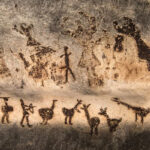We explain and summarize the history of human communication, its means and its characteristics. In addition, its evolution reflected in a timeline.

How was the history of human communication?
The history of human communication It covers a long journey, from the first social manifestations of the human being “Because people could convey their intentions and, perhaps, agree.” even sophisticated communication forms that predominate today.
Human communication is a complex and broad category that includes various forms of information exchange and multiple languages, both verbal and nonverbal, through different channels.
Although communication is an information exchange action between two or more beings, The ability of language is unique and typical of the human being. Language is a sign system that allows expressing thoughts and feelings through the word, and is possible thanks to human intellectual capacity, which reaches sufficient levels of abstraction to create, interpret and learn.
See also: Braille
Origin of human communication
Human communication He was born with the human being himselfbecause it is one of its natural abilities. There is no milestone or date on which we can mark the beginning of the communication of our species, but we can draw a journey of the evolution of communication.
The first forms of human communication were nonverbalsuch as gestures, signs and certain instinctive sounds (onomatopoeia). It is estimated that these forms arose with the appearance of Homo habilisapproximately 2.5 million years ago, since this species developed the ability both to understand and express itself.
As hominids evolved, so did their communicative capacity, Until the articulated language was developed, probably with the appearance of Homo sapiensabout 300,000 years ago. For example, he Homo Neanderthalensis possessed linguistic and communicative abilitiesalthough less developed than the current ones, which allowed him to lead a lifestyle characterized by hunting, collection and nomadic life.
Nonverbal communication

Human language and voice were not the only communication mechanisms of those that the primitive man had. It also had various types of nonverbal communication, that is, the one that did not involve the spoken word.
For example: gestural communication, which is instinctive and Use the body to express emotions or actions. Sometimes, gestures can be considered a form of universal communication, since its meaning is usually easier to interpret than that of a word.
Human voice
The voice was the first form of articulated human language, that is, The language expressed by our phoner apparatus: lungs, throat, vocal strings, larynx, mouth, tongue, lips and teeth. All this at the service of issuing a chain of sounds continuously, organized and consistently, according to the rules dictates a language (or language).
The human voice is our usual communication channeleither live and direct, or through instruments created to amplify it, such as megaphones or microphones. In the times of prehistory (that is, prior to the appearance of writing), the transmission of knowledge depended exclusively on the voice. All knowledge was transmitted from one generation to another orally and preserved in the memory of each individual capable of remembering it.
The custom of transferring knowledge orally developed certain strategies that helped people remember information. For example, The rhyme: a memorization technique based on the similarity of sounds, which allowed to counteract the limitations of human memory.
Writing

Scripture is a system of graphic representation through signs that make up a language. There are as many systems as cultures in the world that have evolved until today.
Among the main writing systems throughout history, the following stand out:
- Pictograms They consisted of a system of signs that represent observable reality, that is, drawings or illustrations organized in a finite series of possibilities that gave them meaning and order. This type of proto -writing was used by diverse cultures from 9000 a. C. and became popular between 6000 and 5000 a. C.
For example: the hieroglyphs created by the Egyptians and the codices developed by the Maya. - Ideograms. They derived from the pictograms and differentiated by the possibility of combining symbols to transmit more complex meanings and abstract concepts. That is, the same symbol could represent different meanings, such as the drawing of some legs that could refer to “legs” (as part of the body) and the “walking action”, according to the context or its combination with other signs.
For example: Kanji or Sinograms used in the Japanese language. - Alphabet. It consisted of an orderly signs system and abstract design. The first alphabet was that of the Phoenicians, around 1000 a. C. The evolution of the alphabet allowed the development of writing systems that last. It consists of the reproduction of signs associated with a specific phonetics, but without direct relation to the objects to which they refer.
For example: the drawing of a flower represents a real flower. However, the word “flower” is an arbitrary combination of literacy signs that only makes sense in a language or culture, and that does not keep a visual relationship with the object that designates.
Postal mail

The exchange of texts written in papers and other physical fiber supports gave rise to shipping and reception systems of cards and parcels in different countries, known as postal emails.
Communication through postal mail required time, since the message sent by the issuer could take weeks or even months to reach the receiver or recipient. From the invention of the steam machine, the delivery times were reduced significantly. However, this model It was replaced at the end of the 20th century by email, or e-mail.
Printed communication
The invention of The Gutenberg printing press in the fifteenth century revolutionized the way to spread the written texts and the books, which until then were elaborated manually and belonged to the most exclusive sectors of the population, such as the nobility and the clergy. As a consequence, the transmission and dissemination of knowledge expanded to the general population in an unprecedented way, which allowed reducing illiteracy levels.
This invention It consisted of the use of metal plates sprinkled with pigments To enter many identical pages in succession and produce mass books. It also facilitated the emergence of the first periodic publications, which could be distributed among hundreds or thousands of citizens.
With the subsequent invention of lithography and other similar techniques, The printing press gave rise to a mass publications market already companies dedicated to written information with the first newspapers and magazines.
Telecommunications

The technological advances arising during the Industrial Revolution significantly impacted the way to create and disseminate the massive contents, through moving images and sounds. In addition, they enabled the transmission of information both by wiring – as in the case of the telephone – and by the Hertzian waves, that is, electromagnetic waves used in the radio.
Thanks to these revolutionary advances, impressive inventions arose during the nineteenth and twentieth centuries: The telegraph, telephone, radio, television and even radar and microwave. These new technologies allowed faster and more massive communications, in addition to connecting people separated by large distances throughout the world.
Information Technologies

The digital revolution of the late twentieth century He completely changed human communication. Computers are machines capable of receiving, storing and transmitting much higher information volumes and speeds much higher than any other previous invention of the human being.
The connection of computers and cell phones through increasingly broad networks, such as the Internet, Allows you to send multimedia messages in real timeperform teleconferences, video recordings, chats, emails – business as personal – and text messages, among other platforms for sending information. This represents a radical change in the way of communicating.
Timeline of human communication
- 200,000 a. C. Emergence of communication through the human voice.
- 50,000 a. C. Creation of the first cave paintings in prehistoric caves.
- 3250 a. C. Creation of Egyptian hieroglyphic writing.
- 1050 a. C. Creation of the first alphabet, developed by the Phoenicians.
- 900 a. C. Establishment of the first postal mail service in China, for bureaucratic purposes.
- 305 d. C. Invention of the symbol reproduction method by wooden plates by the Chinese.
- 1440. Invention of the printing press by German Gutenberg.
- 1814. Development of the first photographic process by the Frenchman Joseph Nicéphore Niépce.
- 1876. Patent of the first phone model by British Alexander Graham Bell.
- 1920. Creation and rapid radio expansion.
- 1927. Broadcast of the first television program, conducted by the London BBC.
- 1962. Launch of the first telecommunications satellite, Telstar I, in the United States.
- 1994. Generalized Internet access for the public worldwide.
Continue with:
document.addEventListener(“DOMContentLoaded”, (e) => {
var sliderContainer, slider;
sliderContainer = document.getElementById(‘block_f90b4e403c445b093f3b078cf542c674’);
if (typeof initSlider !== ‘function’) {
console.log(‘Swiper haven\’t been loaded’);
sliderContainer.className += ‘ fw scroll-snap’;
return;
};
options = {
direction: ‘horizontal’,
speed: 1000,
slidesPerView: ‘auto’,
// slidesPerGroup: 1,
centerInsufficientSlides: true,
// centeredSlides:true,
spaceBetween: 15,
breakpoints: {
720: {
// centeredSlides: false,
// slidesPerGroup: 2,
spaceBetween: 25
},
},
pagination: {
el: ‘.swiper-pagination’,
type: ‘bullets’,
clickable: true
},
}
slider = initSlider(sliderContainer, options);
})
References
- Origins and evolution of human communication (video) at https://www.youtube.com/
- History of communication: evolution from cave paintings to impressive smart mobiles at https://urbancno.com/
- Evolution of Communication At https://www.encycypedia.com/





